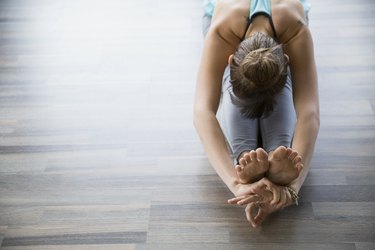
After you finish a tough workout, you should feel sore and a little worn out — as if you have challenged your muscles but will recover with time. While muscle spasms or twitching may be normal, severe spasms that make you feel like your muscles are about to jump out of your skin are not.
You can take some preventive measures to ensure you do not experience this condition again. If you do, however, this may indicate a more serious problem — one that you should discuss with your doctor.
Video of the Day
Video of the Day
Read more: Muscle Twitch & Spasms
Muscle Spasms After Exercise
When you exercise, you contract major muscle groups to build muscle. Pulling in a hand weight toward your chest contracts your biceps muscle, for instance. When you straighten your arm, the muscle lengthens.
You experience exercise-related twitching when you have contracted the muscles, yet a single muscle or muscle filament continues to contract although you are not moving it. Sometimes your muscles may twitch only slightly — so slightly that you do not notice.
Muscle spasms are different because they involve contractions of many muscle fibers. A common example of a muscle spasm or cramp is a charley horse or cramp in the leg. Spasms happen suddenly and can be quite painful when the muscle strongly contracts and becomes hard and tight.
What Causes Twitching and Spasms?
Muscle twitching after exercise is common if you challenge your muscles beyond their typical contraction or when the muscles have been worked to the point of exhaustion. If the muscle is overstretched or torn during exercise, spasms can occur.
Another cause of spasms and twitching is lack of fluids and minerals, such as potassium and calcium, that create electrolyte imbalances, MedLinePlus explains. This is particularly true if you have sweated profusely or are dehydrated when you exercise.
Risk Factors for Muscle Spasms
Several factors increase your risk of muscle spasms after exercise. These include increased age, pregnancy and dehydration. According to Mayo Clinic, conditions such as diabetes and thyroid disorders may also increase your chances of muscle cramps. Certain medications increase risk as well, including diuretics, statin medications and asthma medications, like albuterol, advises WebMD.
Spasm Prevention and Treatment
If you experience muscle difficulties after exercising, you can engage in preventive measures such as stretching before and after your exercise session and drinking plenty of fluids. Increase your exercise difficulty incrementally — not exponentially — by refraining from adding too much weight to your strength-training routine or too much time to your cardiovascular routine.
If you do experience muscle twitches or spasms, try slow, gentle stretches of the muscle. Applying heat and taking a non-steroidal anti-inflammatory medication like ibuprofen can help to relieve pain related to the muscle problem.
Read more: Foods to Help Muscle Spasms
When to Seek Medical Attention
If you experience severe pain or you frequently experience muscle cramps, contact your doctor. If any muscle twitch or spasm lasts a long time or keeps coming back, you may have a serious condition. Examples of conditions that can result in muscle symptoms include kidney or thyroid function alteration or fibromyalgia, according to MedlinePlus.
Is this an emergency? If you are experiencing serious medical symptoms, please see the National Library of Medicine’s list of signs you need emergency medical attention or call 911.